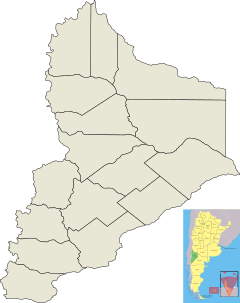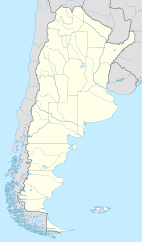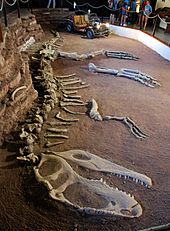Villa El Chocón facts for kids
Quick facts for kids
Villa El Chocón
|
|
|---|---|
|
Municipality and village
|
|
| Country | |
| Province | Neuquén Province |
| Time zone | UTC−3 (ART) |
| Climate | BWk |
Villa El Chocón Cerros Colorados is a small village and town in Neuquén Province, located in southwestern Argentina.
This village was first built to house the workers who were constructing the Ezequiel Ramos Mexía dam. This dam is also known as the El Chocón Dam. It was built on the Limay River. Today, the dam is finished and is one of Argentina's main power plants.
Villa El Chocón is also home to the Ernesto Bachmann Paleontological Museum. This museum shows off many fossils found nearby. The most famous fossil is from a huge dinosaur called Giganotosaurus. Dinosaur footprints have also been found close to the village.
Contents
History of Villa El Chocón
In 1967, the Argentine government created a company called Hidroeléctrica Norpatagónica S.A. (HIDRONOR S.A.). Their goal was to build power plants on the Limay River and the Neuquén River.
In late 1968, HIDRONOR S.A. started building the Chocón-Cerros Colorados Hydroelectric Complex. They set up workshops, roads, and camps. The El Chocón project was very important for Argentina's energy. People even called it "the work of the century."
How the Dam Changed the Area
Building this complex completely changed the area. Before, it was a dry, semi-desert land with few people. These people mostly raised goats and sheep. Soon, a huge artificial lake appeared, along with the dam and the power plant.
A whole new village grew around it. This village had roads, houses, a church, shops, a town hall, and a sports center. It also got its first school. Many trees were planted, and lots of people moved there. Between 1968 and 1972, Villa El Chocón grew very fast. More than 5,000 people came to live there, including workers from other parts of Argentina and other countries.
In December 1972, the first part of the El Chocón power plant started working. The whole project was finished in 1977. After the dam was done, fewer people lived in the village. This was because there were not many other jobs available.
Modern Changes
In the 1990s, Argentina made big changes to its public services. This included selling HIDRONOR S.A. to a private company in 1993.
Villa El Chocón was originally part of the dam project. But after the dam was handed over, the village became part of the province. The local government of El Chocón now takes care of most of the houses and services. These services include keeping up the roads and cleaning. Other private and public companies also help provide services.
Life in Villa El Chocón
Today, Villa El Chocón has about 1,174 people living there. This is more than the 957 people counted in the last survey. There are 579 men and 595 women. The number of homes has also grown from 291 to 498.
Neighborhoods and Facilities
Villa El Chocón has five main neighborhoods: I, II, III, Piedras Coloradas, and Barrio Llequén. Neighborhoods I, II, and III were built mainly for the power plant workers and police officers. People with higher ranks lived in Neighborhood I, and so on.
These neighborhoods are built on hills. Neighborhood III is the highest, and Neighborhood I is the lowest. The houses look very similar: they are rectangular with white walls and red roofs. They have clear backyards, and the houses are close together. The streets are narrow and paved.
The Piedras Coloradas neighborhood is newer. It is also called "140 Lotes." It is located near the Police Department, the Town Hospital, and Neighborhood I.
The village has many important places:
- A Town Hall
- A Tourism office
- The Ernesto Bachmann Museum
- A Paleontology Workshop
- A primary school (School 26) and a secondary school (C. P. E. M. 9)
- A church (Iglesia Espíritu Santo)
- A bank and a local library
- Shops and offices
- A post office and Justice of the Peace
- A bus stop
- A Fire Department and a police station
- A hospital
- Offices for the Argentine National Gendarmerie, forest rangers, and the Argentine Naval Prefecture
- A municipal gym with courts for basketball, tennis, and bowls
- Football fields and a swimming pool
- Camping areas and green spaces
- A beach with white sand
- Hostels and cottages for rent
- A restaurant and a municipal inn
- Overlooks with great views
- Dinosaur footprints
- A YPF service station
- A radio station (FM 106.1)
- The hydroelectric dam
The Iglesia Espíritu Santo (Church of the Holy Spirit) has a unique design. Inside, it looks like Noah's Ark. It displays flags from the countries where the dam builders came from. Outside, its dark green, slanting roof looks like half a pot. This shape represents the dam itself.
Between Neighborhood II and Neighborhood III are the two schools, Primary School 26 and C. P. E. M. 9. All the children and teenagers in the town go to these schools. Across the street from the schools is a square with a playground.
Fun Things to Do
Villa El Chocón has many interesting places to visit:
- The Ernesto Bachmann Paleontological Museum
- The hydroelectric dam
- Many overlooks with great views
- The Cañadón Escondido trail
- The famous dinosaur footprints
- A place called "The Giants"
- The reservoir and the pier
Dinosaur Discoveries
The Ernesto Bachmann Paleontological Museum was created after a huge discovery. In July 1993, Rubén Darío Carolini found the bones of Giganotosaurus carolinii. This was one of the largest meat-eating dinosaurs ever! It was found about 18 kilometers (11.2 miles) southwest of Villa El Chocón.
The museum shows the best-preserved bones of this amazing dinosaur. Scientists believe Giganotosaurus was 12 to 13 meters (about 40 to 43 feet) long. Its skull alone was up to 1.56 meters (over 5 feet) long. It weighed between 6 and 8 tons!
The museum opened on July 10, 1997. On March 16, 1999, it was named after Ernesto Bachmann. He was an amateur paleontologist, just like Carolini. The museum also displays fossils of other ancient sea and land reptiles. You can see bone replicas, fossilized worm trails, and even the car Carolini used.
The El Chocón Hydroelectric Dam
The Ezequiel Ramos Mexía dam is built on the Limay River. It is 262.4 meters (861 feet) deep and covers 315 square miles. It is the largest dam in Argentina. It was built using loose materials like earth and rock.
HIDRONOR started building the dam in 1967. It has been working since 1972. This dam can release a huge amount of water, up to 8,300 cubic meters (about 2.2 million gallons) per second. Today, only 8 people who live in Villa El Chocón work at the dam. Most of the other workers come from different cities.
Most people in Villa El Chocón work for the Town Hall, the Gendarmerie, the Museum, or as police officers. Some residents own shops in the center of the village. Others travel weekly to Neuquén city for work.
See also
 In Spanish: Villa El Chocón para niños
In Spanish: Villa El Chocón para niños







